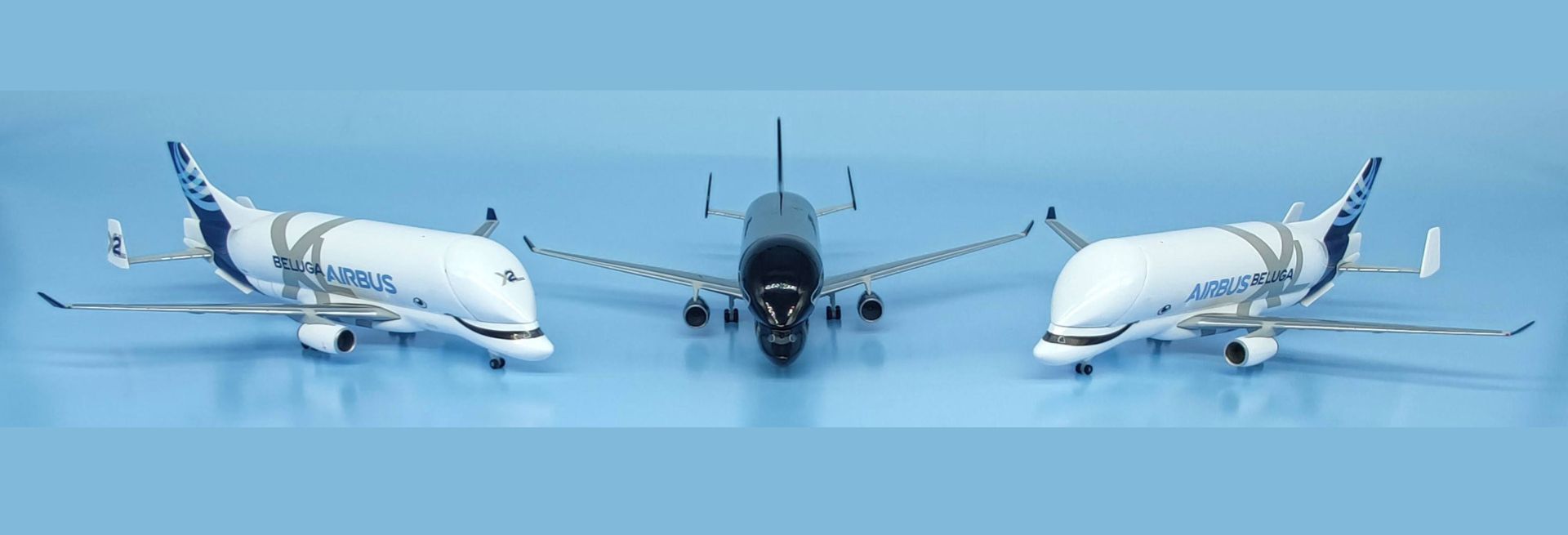
Movable models | Part I
In the more than thirty-year history of Herpa Wings, models have occasionally appeared featuring movable fuselage parts or details that can be displayed in different positions. Although they are far-and-few-between in the overall Herpa Wings collection, they demonstrate the impressive range of display options possible even in this small scale. Peter Vosen introduces us to these models.
The exclusive 1:200 scale models in the "Lufthansa Model Edition", released by Herpa at the end of the 1980s, are still among the most sophisticated aircraft models ever produced. In addition to the hitherto almost unheard-of computer developed detailing and precision printing of even the tiniest contours, the moving parts of these models have been particularly impressive, for example, the rolling and sprung landing gear, and the engine blades, that start to turn in the faintest breeze. As is well known, this model series inspired Herpa to create its "Herpa Wings" model series in the 1:500 scale, which was presented for the first time at the Nuremberg Toy Fair in 1992, and went on sale in specialist retail stores one year later
The model of the World Airways MD-11F appeared in 2007 under item number 507660 with open cargo door and container loader.
The precision of the models in the "Lufthansa Model Edition" was to be transferred as far as possible to the collector-friendly scale of 1:500, something that was achieved largely thanks to the pad printing process. However, the small scale naturally placed limits on the representation of moving parts. Although the smaller models in the early years had a rolling chassis, they were not true to scale. This drew increasing criticism from the rapidly growing collector community, which was mainly interested in the precision and authenticity of the models. In 2001, after a detailed customer survey had been evaluated, Herpa finally decided to replace the rolling undercarriages with detailed, true-to-scale, but no longer movable wheels, which were initially marketed with the additional "New Generation" designation.
Four different versions of the Boeing 747-400F model with movable nose flap were produced exclusively for Luxembourg-based Cargolux. At the back right is the version from 2007 with the identifier LX-WCV "City of Pétange" (502085), to the left is the model with the identifier LX-TCV "City of Sandweiler" (506908) from 2009. At the front left is the model with the identifier LX-YCV "City of Contern" (506991) from 2008 and to the right is the first edition with the identifier LX-VCV "City of Walferdange" (507226) from 2006.
More details resulting from developments in production technology
On the one hand, 30+ years of Wings models in the 1:500 scale means more than 4,000 models of well over 100 different aircraft types, in the colors of more than 650 airlines. On the other, the growing technical possibilities have led to constant refinement of our models in terms of precision, fidelity to the original and, above all, wealth of detail. Indeed, each model is a reflection of its time and the corresponding production possibilities. At the beginning of the 1990s, Herpa broke new ground with the production of airplane models in the 1:500 scale, in particular with its use of precise printing instead of the wet-slide decals that had been the standard on competitor models until then. Since then, Herpa has repeatedly provided innovations, especially with regard to the improved detailing of its molds and printing, and in so doing, evolved into one of the world market leaders for miniature models. Besides growing its range of accessories for airport dioramas, Herpa has repeatedly endeavored to depict fuselage parts such as flaps or doors in various positions, either movable or static, something which remains a great challenge in terms of technical feasibility and cost to this day.
The model of the Lufthansa 747-400M D-ABTB "Brandenburg" (505697) with open cargo door and open doors on the left and right of the front fuselage, appeared in 2006 without and one year later with a silver window frame.
Starting in 2006, Herpa released various versions of the Boeing 747-200F, 747-400F, and 747-400ERF with a movable nose ramp and cone, and in some cases with an open but non-movable cargo door. In contrast to the usual metal models, the hollow fuselage was made of plastic. The models were based on aircraft from well-known cargo airlines such as Air France Cargo, Cargolux, Korean Air Cargo, Lufthansa Cargo, and TNT. One exception was the Christmas model from 2006 (item no. 507288) with a colorful imaginary livery. Another mold novelty from 2006 was the model of the Boeing 747-400M Lufthansa D-ABTB Brandenburg (item no. 505697) with open passenger and cargo doors. However, the doors of this model with a metal fuselage could not be moved. This was followed in 2007 by a metal model of the Boeing MD-11F World Airways N279WA (item no. 507660) with doors that were also open and fixed in place.
The model of the Korean Air Cargo 747-400F HL7449 with movable nose flap (506946) appeared in 2009. In comparison, here is the Korean Air Cargo 747-400F HL7403 without movable nose flap, which was never produced in series.
Several display options
Herpa has been pursuing a slightly different philosophy since 2020 with the Airbus A330-700L BelugaXL. This model has no movable fuselage parts, but the nose door can be displayed in open or closed position with the help of two extra plastic parts provided. The hull of the BelugaXL is hollow and made of metal. In addition to the models based on the real Airbus Industries aircraft, the 2020 Christmas model (item no. 534505) had yet another imaginary livery.
In 2020, the latest Airbus transporter BelugaXL appeared as a mold novelty, here from the left the versions Airbus Industrie XL2 F-GXLH (534284-001), Herpa Christmas 2020 (534505) and Airbus Industrie F-WBXL (534284). The models with a hollow metal fuselage were supplied with two exchange parts made of plastic, with which the bow door can be shown in open and closed condition.
The new development of the Boeing 747-400LCF Dreamlifter in 2024 is similar to the BelugaXL. By combining a hollow metal fuselage with two enclosed plastic parts, it is possible to swivel the tail of the aircraft to one side and thus display it in either the open or closed position. Moreover, the hollow fuselage of these models allows them to be loaded with appropriate items of cargo. The cargo of the Christmas BelugaXL 2020, for example, consisted of the fuselage of a Boeing 707 sporting a Christmas design. With the help of the Christmas 2020 add-on set (item no. 534925), it was possible to assemble a second Christmas model - as a kind of recompense for the Christmas model with item no. 526807, which could not be delivered in 2014. Previously, the 2006 Christmas model had also transported Christmas cargo - a red parcel with a golden ribbon. With the appropriate accessories, such as the container loader (item no. 520621) or Beluga loader, as well as fuselage parts from Rambowings - interesting loading scenes have been realized at many a model airport.
It is true that the selection of models with movable or changeable flaps and doors is limited in comparison to the abundance of models produced in the Herpa Wings collection to date, and the older models of the MD-11 and 747 in particular are now offered at rather steep prices at online auction platforms. However, it is precisely this exclusivity that makes these models so attractive to collectors and enthusiasts.
With the help of the additional parts from the Christmas 2020 add-on sets (534925), a complete Christmas model can be created from the load of the Christmas 2020 model. It serves as a kind of replacement for the Christmas model not delivered in 2014, which was initially announced under item number 526807.
Overview of all models with moving parts
Text: Peter Vosen
Photos: Peter Vosen
Facts and figures
Why doesn't Herpa bring out more models with moving parts? What are the limits of what is feasible? Are further models with variable cargo or passenger doors planned? Stephan Külgen, Product Manager Wings, answers these questions in the second part on this topic.
https://www.herpa.de/en/magazine/Movable-models-Part-II



















